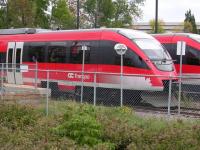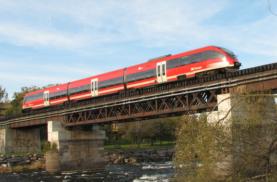 | |
| Two DMU trains on Ottawa's pilot light rail line. |
Ottawa, the capital of Canada, is a small city with a population of about 860,000 for the city itself and 1.15 million for the urban area as a whole. It has relied exclusively on busses for local public transportation since the abandonment of its streetcar system in 1959. The all-bus system includes several bus rapid transit (BRT) lines, which consist of busses running at frequent intervals on mostly exclusive rights of way.
In recent years, however, there has been an increasing interest in light rail transit due to a growing awareness of the limitations of busses and of the boom in construction of light rail systems throughout North America and much of the rest of the world. Thus, the O-train was launched as a pilot line that was expected to be followed by the construction of additional light rail lines.
A major feature of the O-Train line is its very low cost of implementation. It cost US$21 million for the five mile line, or a little over $4 million per mile. This was made possible by utilizing an existing rail line, which is also used occasionally for freight service at night after transit service has ended. The biggest expenditures were for the vehicles, construction of simple, low platform stations, improvements to the track, including the addition of a passing siding at Carlton station, and construction of a simple maintenance facility.
Another major innovation has been the use of diesel multiple units (DMUs) instead of conventional electrically powered light railway vehicles. DMUs allow operation comparable to that of conventional light rail without the need for costly and time-consuming electrification, and they are thus well suited for use on pilot lines as well as lines with relatively low traffic volumes. The attractiveness of using DMUs has increased in recent years due to a number of technology advances which have resulted in reduced emissions, greater fuel efficiency, faster acceleration, lower noise output and simplified maintenance.
The three state-of-the-art, low-floor DMUs trains were built in Germany by Bombardier, the Canadian manufacturer of rail vehicles and other transportation equipment. Each train, which consists of three articulated sections, is 48 meters in length and has a width of 2.9 meters. Capacity is 135 passengers seated plus 150 standing. The maximum speed is 120 kilometers per hour.
In contrast to commuter rail and other passenger services that operate on conventional railroads, there is only a single operator on each O-Train vehicle and no conductor or other personnel on board. Another first is the use of operators who are former transit bus driver and who have been specially trained for this task rather than railroad locomotive engineers. Both of these measures contribute to the low operating costs.
 | |
| A DMU train crossing the Rideau River. |
The main criticism of the line is that it is not long enough and does not extend into Ottawa's downtown. Nevertheless, it still has a good ridership of more than 10,000 trips per day, which substantially exceeds original projections.
There has been considerable enthusiasm among Ottawa's population for adding extensions to the line at both ends as well as for the construction of additional light rail lines. Of particular interest has been an extension into the downtown, as this would add greatly to the convenience of the existing line and undoubtedly result in a large increase in its ridership; however, this has been accompanied by a controversy about whether that segment should run in a tunnel or in the streets. The routes for the other proposed extensions and new lines have also been the subject of much controversy and are mired in local politics, and thus construction is not likely to begin soon.